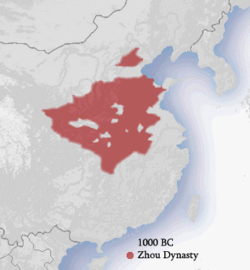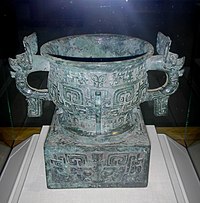ഷൗ രാജവംശം
ഷൗ രാജവംശം 周朝 | |||||||||
|---|---|---|---|---|---|---|---|---|---|
| c. ബി.സി.–256 ബി.സി. | |||||||||
 പടിഞ്ഞാറൻ ഷൗ രാജവംശത്തിന്റെ അതിർത്തികൾ (1050–771 ബി.സി.) | |||||||||
| പദവി | രാജ്യം | ||||||||
| തലസ്ഥാനം | |||||||||
| പൊതുവായ ഭാഷകൾ | പഴയ ചൈനീസ് | ||||||||
| മതം | ചൈനയിലെ പ്രാദേശിക ആരാധനാരീതികൾ, പൂർവ്വികപൂജ, സ്വർഗ്ഗാരാധന[2] | ||||||||
| ഗവൺമെൻ്റ് | ഫ്യൂഡൽ രാജഭരണം | ||||||||
• c. 1046–1043 ബി.സി. | വു രാജാവ് | ||||||||
• 781–771 ബി.സി. | യൗ രാജാവ് | ||||||||
• 770–720 ബി.സി. | പിങ് രാജാവ് | ||||||||
• 314–256 ബി.സി. | നാൻ രാജാവ് | ||||||||
| ചാൻസലർ | |||||||||
| ചരിത്രം | |||||||||
| c. ബി.സി. | |||||||||
| 841–828 ബി.സി. | |||||||||
• വാങ്ചെങ്ങിലേയ്ക്ക് മാറി | 771 ബി.സി. | ||||||||
• ക്വിൻ നാൻ രാജാവിനെ പുറത്താക്കിയത് | 256 ബി.സി. | ||||||||
• അവസാന ഷൗ സ്ഥാനങ്ങൾ പരാജയപ്പെട്ടു[3] | 249 ബി.സി. | ||||||||
| Population | |||||||||
• 273 ബി.സി. | 30,000,000 | ||||||||
• 230 ബി.സി. | 38,000,000 | ||||||||
| നാണയവ്യവസ്ഥ | കൂടുതലും സ്പേഡ് കോയിനുകളും നൈഫ് കോയിനുകളും | ||||||||
| |||||||||
| ഇന്ന് ഇത് ഈ രാജ്യങ്ങളുടെ ഭാഗമാണ്: | |||||||||
| ഷൗ രാജവംശം | |||||||||||||||||||||||||||||||
 "Zhou" in ancient bronze script (top), seal script (middle), and modern (bottom) Chinese characters | |||||||||||||||||||||||||||||||
| Chinese | 周朝 | ||||||||||||||||||||||||||||||
|---|---|---|---|---|---|---|---|---|---|---|---|---|---|---|---|---|---|---|---|---|---|---|---|---|---|---|---|---|---|---|---|
| |||||||||||||||||||||||||||||||
 | |||||||
|---|---|---|---|---|---|---|---|
| ANCIENT | |||||||
| 3 Sovereigns and 5 Emperors | |||||||
| Xia Dynasty 2100–1600 BC | |||||||
| Shang Dynasty 1600–1046 BC | |||||||
| Zhou Dynasty 1045–256 BC | |||||||
| Western Zhou | |||||||
| Eastern Zhou | |||||||
| Spring and Autumn Period | |||||||
| Warring States Period | |||||||
| IMPERIAL | |||||||
| Qin Dynasty 221 BC–206 BC | |||||||
| Han Dynasty 206 BC–220 AD | |||||||
| Western Han | |||||||
| Xin Dynasty | |||||||
| Eastern Han | |||||||
| Three Kingdoms 220–280 | |||||||
| Wei, Shu & Wu | |||||||
| Jin Dynasty 265–420 | |||||||
| Western Jin | 16 Kingdoms 304–439 | ||||||
| Eastern Jin | |||||||
| Southern & Northern Dynasties 420–589 | |||||||
| Sui Dynasty 581–618 | |||||||
| Tang Dynasty 618–907 | |||||||
| ( Second Zhou 690–705 ) | |||||||
| 5 Dynasties & 10 Kingdoms 907–960 |
Liao Dynasty 907–1125 | ||||||
| Song Dynasty 960–1279 |
|||||||
| Northern Song | W. Xia | ||||||
| Southern Song | Jin | ||||||
| Yuan Dynasty 1271–1368 | |||||||
| Ming Dynasty 1368–1644 | |||||||
| Qing Dynasty 1644–1911 | |||||||
| MODERN | |||||||
| Republic of China 1912–1949 | |||||||
| People's Republic of China 1949–present |
Republic of China (Taiwan) 1945–present | ||||||
ഷാങ് രാജവംശത്തിന് ശേഷവും ക്വിൻ രാജവംശത്തിന് മുൻപായും ചൈന ഭരിച്ചിരുന്ന രാജവംശമാണ് ഷൗ രാജവംശം (ചൈനീസ്: 周朝; പിൻയിൻ: Zhōu cháo [ʈʂóu ʈʂʰǎu]). മറ്റേതൊരു രാജവംശത്തേക്കാൾ അധികം കാലം ചൈന ഭരിച്ചുവെങ്കിലും പടിഞ്ഞാറൻ ഷൗ എന്നറിയപ്പെടുന്ന കാലഘട്ടത്തോടെ ഈ രാജവംശത്തിന് ചൈനയുടെ മേലുള്ള രാഷ്ട്രീയവും സൈനികവുമായ നിയന്ത്രണം അവസാനിക്കുകയുണ്ടായി. ചൈനയിലെ ഓട്ട് നിർമ്മാണം അതിന്റെ പരകോടിയിലെത്തിയത് ഈ കാലഘട്ടത്തിലാണ്. ലിപി ആധുനികരൂപത്തിലെത്തിയതും ഷൗ കാലഘട്ടത്തിലാണ്.
ചരിത്രം
[തിരുത്തുക]ദിവ്യഗർഭത്തിലൂടെ ഉണ്ടായി എന്ന് വിശ്വസിക്കുന്ന ക്വി എന്ന വ്യക്തിയാണ് കഥകളിൽ ഷൗ രാജവംശത്തിന്റെ ആദ്യ കണ്ണി. ഇദ്ദേഹം ചെറുപ്പകാലത്ത് മൂന്ന് തവണ മരണത്തിൽ നിന്ന് അത്ഭുതകരമായി രക്ഷപെടുകയുണ്ടായി. ക്വി ചൈനയിലെ കൃഷി മെച്ചപ്പെടുത്തി എന്നാണ് വിശ്വാസം. ക്വിയുടെ മകൻ ബുഷു കൃഷി ഉപേക്ഷിച്ചു എന്ന് വിശ്വസിക്കപ്പെടുന്നു.[4] പിൻഗാമിയായ ലിയു,[5] കൃഷി പുനരാരംഭിക്കുകയും ബിൻ,[iii] എന്ന സ്ഥലത്ത് താമസമാക്കുകയും ചെയ്തു. ഇദ്ദേഹത്തിന്റെ പിൻഗാമികൾ തലമുറകളോളം ഇവിടം ഭരിച്ചു. തായി രാജാവ് പിന്നീട് ഇവരെ വൈ നദിയുടെ താഴ്വരയിലുള്ള ഷൗ എന്ന പ്രദേശത്തേയ്ക്ക് കൊണ്ടുപോയി. ഷാങ് രാജാക്കന്മാർക്കുവേണ്ടി പല സിറോങ് ഗോത്രങ്ങളെയും കീഴടക്കിയ ജിലി പിന്നീട് അധികാരത്തിൽ വന്നു. ഇദ്ദേഹത്തെ ചതിച്ച് കൊലപ്പെടുത്തുകയാണുണ്ടായത്. ഇദ്ദേഹത്തിന്റെ സഹോദരന്മാരായ വു യി, വെൻ ഡിങ് എന്നിവർ യാങ്സി നദീതടത്തിലേയ്ക്ക് ഓടിപ്പോയി അവിടെ വു രാജ്യം സ്ഥാപിച്ചു. ജിലിയുടെ മകൻ വെൻ കൈക്കൂലി കൊടുത്ത് തടവിൽ നിന്ന് രക്ഷപെടുകയും ഷൗ തലസ്ഥാനം ഫെങ് എന്ന സ്ഥലത്തേയ്ക്ക് (ഇന്നത്തെ സിയാൻ) മാറ്റുകയും ചെയ്തു. 1046 ബി.സി.യോടടുത്ത് വെനിന്റെ മകൻ വു, കൂട്ടാളിയായ ജിയാങ് സിയ എന്നിവർ 45,000 പേരും 300 രഥങ്ങളും ഉൾപ്പെട്ട സൈന്യം മഞ്ഞനദിയ്ക്ക് കുറുകേ നയിച്ച് ഷാങ് രാജവംശത്തിലെ ഷൗ രാജാവിനെ മുയേ യുദ്ധത്തിൽ പരാജയപ്പെടുത്തി. ഇത് ഷൗ രാജവംശത്തിന്റെ തുടക്കം കുറിച്ചു.[iv] ഷാങ് രാജവംശത്തിലെ ഒരംഗത്തെ സോങ്ങിന്റെ ഡ്യൂക്ക് എന്ന സ്ഥാനം നൽകി നിലനിർത്തി.
സംസ്കാരം
[തിരുത്തുക]ഷൗ ഉപയോഗിച്ചിരുന്ന ഭാഷ ഷാങ് ഭാഷയിൽ നിന്ന് വ്യത്യസ്തമായിരുന്നില്ല.[8] ഷാങ് സംസ്കാരത്തെ ഷൗ രാജവംശം സ്വാംശീകരിക്കുവാൻ ശ്രമിച്ചിരുന്നു.[9][10]
സംസ്കാരവും സമൂഹവും
[തിരുത്തുക]
സ്വർഗ്ഗം നൽകിയ ഭരണാധികാരം
[തിരുത്തുക]
ചൈനീസ് പാരമ്പര്യമനുസരിച്ച് ഷൗ ഷാങ് രാജവംശത്തെ പരാജയപ്പെടുത്തിയശേഷം പൂർവ്വികാരാധനയ്ക്ക് പകരം എല്ലാവർക്കും ആരാധിക്കാവുന്ന ദൈവങ്ങളിലേയ്ക്ക് മാറി. ടിയാൻ അല്ലെങ്കിൽ സ്വർഗ്ഗമായിരുന്നു പുതിയ ആരാധനാമൂർത്തി. "സ്വർഗ്ഗം നൽകിയ ഭരണാധികാരം" തങ്ങൾക്കുണ്ടെന്നായിരുന്നു ഷൗ ഭരണാധികാരികൾ അവകാശപ്പെട്ടത്. ഭരണാധികാരി "സ്വർഗ്ഗപുത്രൻ" ആണെന്നും ദൈവികമായ അധികാരം അദ്ദേഹത്തിനുണ്ടെന്നും ഭരണം നഷ്ടപ്പെട്ടാൽ അതിനർത്ഥം സ്വർഗ്ഗത്തിന്റെ അംഗീകാരം അദ്ദേഹത്തിന് നഷ്ടപ്പെട്ടു എന്നുമായിരുന്നു. ഷാങ് രാജവംശം തിന്മയുടെ പ്രതിരൂപമായിരുന്നു എന്നും അതിനാലാണ് തങ്ങൾക്ക് ഭരണം ലഭിച്ചത് എന്നുമായിരുന്നു ഷൗ വിശ്വാസം.[11]
ഫ്യൂഡൽ വ്യവസ്ഥ
[തിരുത്തുക]
ഇക്കാലത്ത് യൂറോപ്പിലെ മാതിരി ഫ്യൂഡൽ സിസ്റ്റമാണ് നിലനിന്നിരുന്നത് എന്നാണ് ചരിത്രകാരന്മാർ രേഖപ്പെടുത്തിയിരിക്കുന്നത്. രാജവംശം സ്ഥാപിച്ചപ്പോൾ ഭൂമി തിരിച്ച് പരമ്പരയായി അനുഭവിക്കാവുന്ന രീതിയിൽ കുടുംബങ്ങൾക്ക് നൽകുകയുണ്ടായി. ഇവർ പിൽക്കാലത്ത് രാജാവിനേക്കാൾ ശക്തരായി മാറുകയുമുണ്ടായി. പിതാവ് വഴിയുള്ള പരമ്പര മാത്രമേ നിയമപരമായി ഇവർ കണക്കാക്കിയിരുന്നുള്ളൂ.[12][13]
മൂത്ത പുത്രന്മാരെ അധികാരമേൽപ്പിക്കുകയും ഇളയ സഹോദരന്മാരെ കുറഞ്ഞ സ്ഥാനത്തോടുകൂടിയ പുതിയ വംശങ്ങൾ സ്ഥാപിക്കാൻ അനുവദിക്കുകയുമായിരുന്നു ചെയ്തിരുന്നത്. ഭരണത്തിലിരിക്കുന്നയാളോടുള്ള ബന്ധം കുറയുന്തോറും രാഷ്ട്രീയാധികാരം കുറഞ്ഞുവരും. ഈ സമ്പ്രദായം പിന്നീട് കൊറിയയിലേയ്ക്കും വ്യാപിക്കുകയുണ്ടായി.[14]
കൃഷി
[തിരുത്തുക]വെള്ളം തിരിച്ചുവിട്ട് ജലസേചനത്തിനുപയോഗിക്കാനുള്ള വലിയ പദ്ധതികൾ ഇക്കാലത്ത് നടപ്പിലാക്കപ്പെട്ടിരുന്നു. നദികളിൽ അണക്കെട്ടുകൾ നിർമ്മിക്കപ്പെട്ടിരുന്നു. ജലസേചനത്തിനായി വലിയ കനാൽ ശൃംഖലകൾ സ്ഥാപിക്കപ്പെട്ടിരുന്നു.
സൈന്യം
[തിരുത്തുക]ആദ്യകാലത്തെ പടിഞ്ഞാറൻ ഷൗ രാജ്യത്തിന് വലിയ സൈന്യമുണ്ടായിരുന്നു. ഷാവോ രാജാവിന്റെ ഭരണത്തിന്റെ പത്തൊൻപതാം വർഷമായിരുന്നു ഇവരുടെ സൈനികശക്തി ഏറ്റവും മെച്ചപ്പെട്ട നിലയിലെത്തിയത്. ഹാൻ നദിയുടെ തീരത്തുള്ള ഒരു സൈനിക നീക്കത്തിനിടെ ഇദ്ദേഹത്തിന്റെ സൈന്യത്തിന്റെ പാതി നശിക്കുകയും രാജാവ് മരണമടയുകയും ചെയ്തു. സംസ്കാരരഹിതർ എന്ന് വിളിച്ചിരുന്ന അതിർത്തിക്കപ്പുറത്തുള്ള ജനവിഭാഗങ്ങൾക്കെതിരേയായിരുന്നു ഇവരുടെ ആക്രമണങ്ങൾ.
ഷൗ കാലഘട്ടത്തിലാണ് ചൈനയിൽ രഥങ്ങൾ യുദ്ധത്തിൽ ഉപയോഗിക്കാൻ ആരംഭിച്ചത്.[15][16]
തത്ത്വശാസ്ത്രം
[തിരുത്തുക]ഷൗ ഭരണകാലത്ത് ചൈനീസ് തത്ത്വശാസ്ത്രത്തിന്റെ ആരംഭഘട്ടമായിരുന്നു. പിൽക്കാലത്ത് വലിയ സ്വാധീനമുണ്ടാക്കിയ തത്ത്വചിന്തകരായിരുന്ന കൺഫൂഷ്യസ്, ലാവോസെ എന്നിവർ ഇക്കാലത്ത് ജീവിച്ചിരുന്നു. മോഷി, മെൻസിയസ്, ഷാങ് യാങ്, ഹാൻ ഫേയ് എന്നിവർ ഇക്കാലത്ത് ജീവിച്ചിരുന്നവരാണ്.[17]
രാജാക്കന്മാർ
[തിരുത്തുക]ഷാങ് ഭരണാധികാരികളെപ്പോലെതന്നെ ഷൗ രാജവംശത്തിലെ ഭരണാധികാരികളുടെയും സ്ഥാനപ്പേര് വാങ് (王) എന്നായിരുന്നു. ഈ സ്ഥാനം മലയാളത്തിൽ "രാജാവ്" എന്ന് തർജ്ജമ ചെയ്യാവുന്നതാണ്. ഷാങ് രാജാക്കന്മാരുടെ സാമന്തന്മാരായിരുന്നുവെങ്കിലും വു രാജാവിന്റെ പൂർവ്വികരായ – ഡാൻഫു, ജിലി, വെൻ – എന്നിവരെയും "ഷൗ രാജാക്കന്മാർ" എന്ന് വിളിക്കാറുണ്ട്.
ഇതും കാണുക
[തിരുത്തുക]- ഷൗ രാജവംശത്തിന്റെ വംശാവലി
- നാല് അധിനിവേശങ്ങൾ
- ചൈനയുടെ ചരിത്രത്തിലെ വിവിധ തലസ്ഥാനങ്ങൾ
- സെങ് മാർക്വി യിയുടെ ശവക്കല്ലറ
കുറിപ്പുകൾ
[തിരുത്തുക]അവലംബം
[തിരുത്തുക]- ↑ 1.0 1.1 1.2 "Considering Chengzhou ("Completion of Zhou") and Wangcheng ("City of the King")" (PDF). Xu Zhaofeng. Archived from the original (PDF) on July 22, 2015. Retrieved 22 July 2015.
- ↑ "Encyclopædia Britannica: Tian". Retrieved 17 August 2015.
- ↑ Schinz (1996), പുറം. 80.
- ↑ Sima Qian. Records of the Grand Historian, Annals of Zhou, §3.
- ↑ Wu (1982), പുറം. 235.
- ↑ Shaughnessy (1999), പുറം. 303.
- ↑ Wu (1982), പുറം. 273.
- ↑ David McCraw (2010). "An ABC Exercise in Old Sinitic Lexical Statistics" (PDF). Sino-Platonic Papers (202).
- ↑ Jessica Rawson, 'Western Zhou Archaeology,' in Michael Loewe, Edward L. Shaughnessy (eds.), The Cambridge History of Ancient China: From the Origins of Civilization to 221 B.C., Cambridge University Press 1999 pp.352-448 p.387.
- ↑ Li, Feng (2006), Landscape And Power In Early China, Cambridge University Press, p. 286.
- ↑ Pollard, Elizabeth (2015). Worlds Together Worlds Apart. 500 Fifth Ave New York, NY: W.W. Norton& Company Inc. p. 146. ISBN 978-0-393-12376-0.
{{cite book}}: CS1 maint: location (link) - ↑ Brashier, K. E. (2011-01-01). Ancestral Memory in Early China. ISBN 9780674056077.
- ↑ The ramage system in China and Polynesia Li Hwei http://c.ianthro.tw/sites/c.ianthro.tw/files/da/df/401/401104_0001.pdf Archived 2013-09-21 at the Wayback Machine.
- ↑ The Confucian Transformation of Korea: A Study of Society and Ideology Written By Martina Deuchler https://books.google.com/books?id=NQeeYOyUx64C&pg=PA129
- ↑ Ebrey, Walthall & Palais (2006), പുറം. 14.
- ↑ Shaughnessy (1988).
- ↑ Schirokauer & Brown (2006), പുറങ്ങൾ. 25–47.
- അവലംബമായി ഉപയോഗിച്ചിരിക്കുന്ന ഗ്രന്ഥങ്ങൾ
- Beckwith, Christopher I. (16 March 2009). Empires of the Silk Road: A History of Central Eurasia from the Bronze Age to the Present. Princeton University Press. ISBN 1400829941. Retrieved 30 December 2014.
{{cite book}}: Invalid|ref=harv(help) - Schinz, Alfred (1996). Axel Menges (ed.). The Magic Square: Cities in Ancient China. Stuttgart, London: Daehan Printing & Publishing Co.
{{cite book}}: Invalid|ref=harv(help) - Kleeman, Terry F. (1998). Great Perfection: Religion and Ethnicity in a Chinese Millennial Kingdom. University of Hawaii Press. ISBN 0824818008. Retrieved 31 December 2014.
{{cite book}}: Invalid|ref=harv(help) - Bodman, Nicholas C. (1980), "Proto-Chinese and Sino-Tibetan: data towards establishing the nature of the relationship", in van Coetsem, Frans; Waugh, Linda R. (eds.), Contributions to historical linguistics: issues and materials, Leiden: E. J. Brill, pp. 34–199, ISBN 978-90-04-06130-9.
- Chinn, Ann-ping (2007), The Authentic Confucius, Scribner, ISBN 0-7432-4618-7
- Ebrey, Patricia Buckley; Walthall, Anne; Palais, James B. (2006), East Asia: A Cultural, Social, and Political History, Boston: Houghton Mifflin Company, ISBN 0-618-13384-4
- Gernet, Jacques (1996), A History of Chinese Civilization (Second ed.), Cambridge University Press, ISBN 0-521-49781-7
- Hucker, Charles O. (1978), China to 1850: A short history, Stanford University Press, ISBN 0-8047-0958-0
- Krech, Volkhard; Steinicke, Marian (2011). Dynamics in the History of Religions between Asia and Europe: Encounters, Notions, and Comparative Perspectives. Brill. ISBN 9004225358. Retrieved 30 December 2014.
{{cite book}}: Invalid|ref=harv(help) - Khayutina, Maria (2003), "Where Was the Western Zhou Capital?", The Warring States Working Group, WSWG-17, Leiden, Germany: Warring States Project, p. 14, archived from the original (PDF) on 2010-05-29, retrieved 2016-11-13
- Schirokauer, Conrad; Brown, Miranda (2006), A Brief History of Chinese Civilization (Second ed.), Wadsworth: Thomson Learning, pp. 25–47
- Shaughnessy, Edward L. (1988), "Historical Perspectives on The Introduction of The Chariot Into China", Harvard Journal of Asiatic Studies, 48 (1): 189–237, doi:10.2307/2719276, JSTOR 2719276
- Shaughnessy, Edward L. (1999), "Western Zhou History", in Loewe, Michael; Shaughnessy, Edward L. (eds.), The Cambridge History of Ancient China, pp. 292–351, ISBN 978-0-521-47030-8
- Wu, K. C. (1982), The Chinese Heritage, New York: Crown Publishers, ISBN 0-517-54475-X
കൂടുതൽ വായനയ്ക്ക്
[തിരുത്തുക]- Fong, Wen, ed. (1980), The great bronze age of China: an exhibition from the People's Republic of China, New York: The Metropolitan Museum of Art, ISBN 978-0-87099-226-1.
- Lee, Yuan-Yuan; Shen, Sinyan (1999), Chinese Musical Instruments, Chinese Music Monograph Series, Chinese Music Society of North America Press, ISBN 978-1-880464-03-8.
- Li, Feng (2006), Landscape and Power in Early China: The Crisis and Fall of the Western Zhou 1045–771 ബി.സി., Cambridge University Press, ISBN 978-0-521-85272-2.
- Shen, Sinyan (1987), "Acoustics of Ancient Chinese Bells", Scientific American, 256 (4): 94, doi:10.1038/scientificamerican0487-104.
- Sun, Yan (2006), "Cultural and Political Control in North China: Style and Use of the Bronzes of Yan at Liulihe during the Early Western Zhou", in Mair, Victor H. (ed.), Contact and Exchange in the Ancient World, Honolulu: University of Hawai'i Press, pp. 215–237, ISBN 978-0-8248-2884-4.
- Wagner, Donald B. (1999), "The Earliest Use of Iron in China", in Young, S. M. M.; Pollard, A. M.; Budd, P.; Ixer, R. A. (eds.), Metals in Antiquity, Oxford: Archaeopress, pp. 1–9, ISBN 978-1-84171-008-2.
{{citation}}: Unknown parameter|displayeditors=ignored (|display-editors=suggested) (help)
പുറത്തേയ്ക്കുള്ള കണ്ണികൾ
[തിരുത്തുക]- Chinese Text Project, Rulers of the Zhou period – with links to their occurrences in pre-Qin and Han texts.
ഉദ്ധരിച്ചതിൽ പിഴവ്: <ref> റ്റാഗുകൾ "lower-roman" സംഘത്തിൽ ഉണ്ട്, പക്ഷേ ബന്ധപ്പെട്ട <references group="lower-roman"/> റ്റാഗ് കണ്ടെത്താനായില്ല
